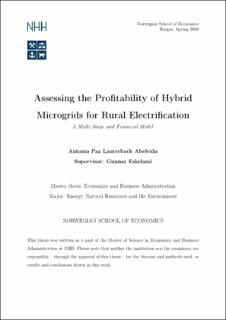Assessing the profitability of hybrid microgrids for rural electrification : a multi stage and financial model
Master thesis
Permanent lenke
https://hdl.handle.net/11250/2736654Utgivelsesdato
2020Metadata
Vis full innførselSamlinger
- Master Thesis [4372]
Sammendrag
Electricity access expansion is currently one of the main issues in the global agenda,
considering the benefits that electrification brings to human society. A lot has been
achieved in the past years, however, rural areas in developing countries are still lagging
behind. These are usually difficult to access and not very densely populated, making
project design expensive and challenging. In this context, hybrid microgrids separated
from the central grid have risen as a promising and cleaner solution. Nevertheless, these
require significant investment costs that, given the features of the geographies in need,
will probably not be covered by the population to be served nor by the local government.
This makes private investor participation the key to be able to develop these projects.
Although, due to the high-risk nature of the venture the private sector is increasingly
reluctant to step in. To address this issue, a multi-stage model approach feeding into
a project finance-based financial model was developed in this study, with the aim of
determining under which conditions it is profitable for private investors to develop hybrid
microgrid electrification projects. For illustrative purposes, the models were based in a
rural village in north-west Haiti, Anse Rouge. In the first stage, the village is characterized,
determining the demand or electricity needed and thus the supply microgrid prototype. In
a second stage, using outputs of the first, a project finance-based financial model was built
from which minimum tariffs to make the venture profitable to investors were obtained.
Finally, the conditions under which the tariffs obtained in the financial analysis could be
charged were discussed, which will greatly depend on the efforts of the developer, the
energetic potential, the acceptance of the community, and the quality of institutions. In
the case of Anse Rouge, the profitable tariffs are high but feasible in relation to the past
adoption of other rural Haitian settlements, however, there are relevant institutional and
political risks that explain the underdevelopment of these projects in the country.
Keywords – Rural Electrification, Project Finance, Haiti, SDG7
